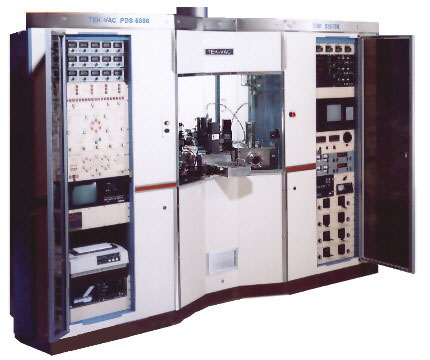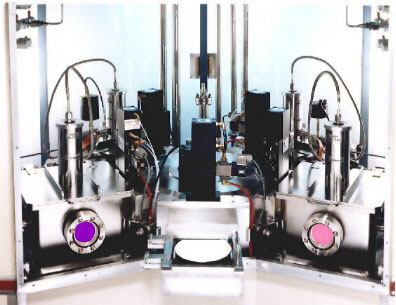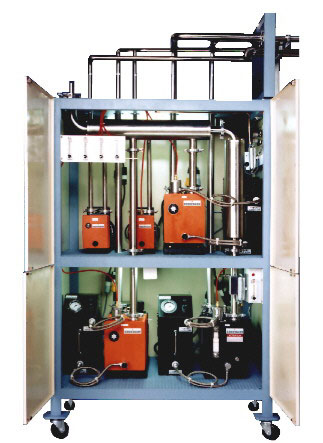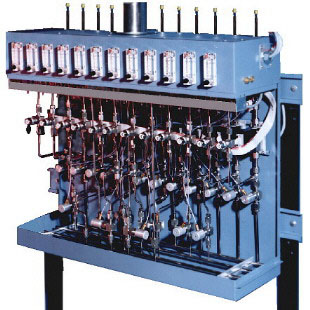

FEATURES:
Standard System Configuration
One centrally located robot with four
access ports.
| Four process chambers, one central loadlock,
and one clean room load lock.
| Two 330 liter/second turbomolecular pump
serving all process chambers.
| Options of 104 CFM Roots Blowers each
backed by a 27 CFM rotary vane pumps.
| |
Instrumentation per process chamber
Six Electronic Mass Flow Controllers
| PID digital temperature controller
| One kilowatt SCR power pack
| 1.5" throttle valve and valve controller
| 0-10 torr capacitance manometer and digital
readout
| |
Instrumentation, general
Bayard-Alpert ionization gauge
| 300 watt, 13.56 MHZ, R.F. power supply
| 700 volt, 0.5 amp, D.C. power supply
| Illuminated valve control panel
| Robot control panel
| Turbo molecular power supply
| |
INTRODUCTION:
The Tek-Vac PDS-6000 is a multifunction, multi-chamber plasma processing system for the deposition, etch, and fabrication of semi-conducting materials and devices. The concepts incorporated into this system are based upon Tek-Vac Industries, Inc., proprietary designs for a distributed system, the principal features of which are outlined as follows.
The system consists of five (5) chambers total; four (4) process and one (1) centrally located. A clean room wafer insertion loadlock is available.
The transfer mechanism is designed to accurately and reproducibly locate 6" round or smaller substrates within each process chamber. Each process chamber is separated from the central chamber by a rectangular gate valve. The process chambers have separate gas pumping and flow lines, and individual automatic matching networks for independent operation. The plasma process in each process chamber is of the parallel plate capacitance type. The substrates, which can weigh up to 250 grams, are processed on the upper and lower electrodes, as specified.
The "robot arm" holding a substrate, performs two functions. The robot can rotate 360 degrees to position the substrate in front of the appropriate process/load lock chamber and both extends and retracts to load or unload the substrate into the designated chamber. The system design is not limited to four chambers. Depending upon the substrate size, eight or more chambers could surround the central chamber, making the distributed design a contender for "production processing". Each process chamber is generally dedicated to a single type of process. The processes available are:
Designs for ICP and ECR high-density plasma sources can be incorporated.
The above processes can be set up for inverted or non-inverted substrates.
CENTRAL SUBSTRATE TRANSFER MECHANISM:
The Substrate Transfer Mechanism has four design features:
Compound motion is employed to reduce the size of the central chamber. The Transfer Mechanism contains a 2:1 compound motion allowing for a 17" reach and 17" central chamber diameter. A viewport for inspection is centrally located in the top plate of the central chamber for easy viewing access.
The mechanism contains no rubbing surfaces. All motion is supported by precision ball bearings.
The motion which moves the substrate transfer mechanism is transmitted into the central chamber through two separate shafts.
The substrate transfer mechanism is designed to handle and place substrates into the deposition chambers in the non-inverted deposition model. Substrate deposition in the inverted mode is available as an option. The loading, unloading and choice of chambers is selected by the operator via switch selection from a control panel. Six (6) functions are available to the operator:
Only one function may be selected at a time. The selection of function 1 through 4 causes the substrate transfer mechanism to rotate the substrate to the chamber selected irrespective of its present position. The selection of function 5 or 6 causes the substrate transfer mechanism to either load or unload as the operator chooses. All the logic required for function 1 through 6 is transparent to the operator, that is, no other operator intervention is required.

PROCESS CHAMBERS
Each of the four (4) process chambers is devoted to a particular mode of operation. The available modes are listed in the introduction. Chambers are available in stainless steel or aluminum construction. The aluminum chambers are constructed of 6061-T6 alloy. They may be supplied anodized for an etch resistant finish. The stainless steel chambers are constructed of 304 alloy.
The square chambers utilize prebaked elastomer "O" rings for cover and baseplate sealing. The ports on the aluminum chambers are sealed by elastomer "O" rings. The ports on the stainless steel chambers are supplied with either metal sealed or elastomer "O" ring sealed flanges according to the customers specifications.
The standard port configuration for the rectangular chambers consists of; one 3" view port, four 1.5" instrumentation ports, one 4" high vacuum pumping port and one 6.5" x 1.25" port for access to the robot. Two of the 1.5" ports are in line of sight and a third 1.5" port is at right angles to these two.
The instrumentation ports and the viewing port are located at the plasma level for ease of viewing and optimal plasma diagnostics. Located in the baseplate are two 1.5" pumping ports. The 0.5" ports are for connection to gas handling devices and pressure sensing devices. All chamber designs are bakeable to 150 degrees C. The UHV chambers may be baked to 250 degrees C depending upon the sealing configurations selected.
PLASMA POWER SUPPLIES
Each chamber is equipped with a dedicated automatic matching network (AMN). All matching networks feature manual override.
Standard power supplies are one 500 watt solid state 13.56 MHZ generator, one 600 watt generator with a variable frequency of 10 to 110 KHZ and one 0-750 volt D.C. power supply. The D.C. supply is used for cathodic biasing or D.C. glow discharge. Any power supply can be directed to any chamber. The 13.56 MHZ supply and the D.C. supply can be directed to the same chamber simultaneously.

VACUUM SYSTEM
The process chamber and central robot chamber are rough pumped by an 11 CFM mechanical pump through 1 ½" pumping lines. Two 104 CFM Roots Blowers backed by 27 CFM mechanical pumps are connected to the system with 1 ½" pumping lines. Configurations with mechanical process pumps are available. One Roots Blower is generally used for pumping oxidizing gases and the other Roots Blower is used to pump reducing gases. Both pumps are charged with Fomblin oil. All pumps in the system are corrosion resistant and the mechanical pumps backing the Roots Blowers have oil filtration systems. Either Roots Blower may be connected to any process chamber or combination of process chambers as desired.
High vacuum pump down of process chambers is accomplished with a 330 liter/second turbomolecular pump backed by an 11 CFM mechanical pump. The turbomolecular pump is connected to the process chamber by 4" pumping lines. The turbomolecular pump can also be used to pump process gases at pressures below 100 millitorr.

GAS HANDLING SYSTEM
All chambers have identical gas handling features and they all use downstream pressure control. Located between the chambers and the Roots Blowers are 1 ½ Servo throttle valves. These valves maintain pressure by comparing the chamber pressure to a user selected setpoint pressure. The Servo throttle valve adjusts its conductance until the two pressure setpoints are equal. Chamber pressure is monitored with 0-10 torr capacitance manometers. All gas handling lines are ½" stainless steel seamless tubing. The tubing is cleaned and micropolished prior to assembly. All fabricated parts are welded and reusable connections are made with metal gasket fittings. The gases flowing into the process chamber are controlled with Electronic Mass Flow Controllers. Any number of Electronic Mass Flow Controllers can be connected to each process chamber.
SPECIFICATIONS
COMPUTER INTERFACING
The PDS-6000 is supplied computer interface ready. All the electropneumatic valves can be controlled from either the instrument control panel or by 0-5 volt TTL logic levels. The method of control is determined by the system operator via a front panel switch labeled manual/auto.
The mass flow controllers, R.F. generators, throttle valves and platen heaters can all be controlled with either 0-10 volt or 0-5 volt analog signals.
The mass flows, chamber pressures, ion gauge pressure, deposition platen temperatures and thermocouple gauge setpoints can all be monitored by computer or data logger while the system is under manual or automatic control.
A complete menu driven computer system can be factory installed. The basic system includes a monitor, disk/hard drives, keyboard & printer. A card cage is supplied which connects to the computer by a GPIO interface. Inside the card cage are contained all necessary interface modules. Includes are digital to analog converter (DAC), analog to digital converter (ADC), BCD conversion, event sense, TTL output and TTL input. Options available are stepping motor control and communication protocols such as IEEE-488.
OPTIONS AND SPECIALS
A large variety of options are available. Some of the more common choices are the substitutions of aluminum chambers for stainless steel and all metal sealed chambers for use in ultra-high vacuum service. An external load lock is available which allows all four chambers surrounding the central robot to be used for processing. Samples can be processed in the inverted (upside-down) position if necessary. Another popular option has been the addition of a 25 KHz-125KHz low frequency generator. Special chamber designs, pumping systems or instrumentation can be accommodated.